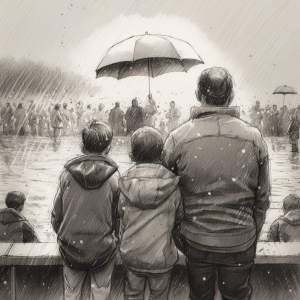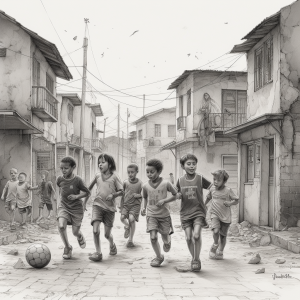The basic requirements for playing Soccer, especially at youth level are simple, a ball that bounces and a pair of legs that bend to chase the ball. Anyone that can fulfill the 2 requirements can start to play Soccer and the rest can be acquired later through dedication and training. One of the greatest advantages of playing Soccer is that it’s a game that suits all children. Any fit and healthy child can play it regardless of build, race or social background.The world has seen tall, short, portly, spindly, barrel-chested and even over weight soccer players turn their physical differences into positive advantages.
The likes of Crouch, one of the tallest soccer players has made himself into a household name at Liverpool and now at Pourtsmouth. The stocky physiques of Paul Gascoine and Vinnie Jones became monsters on the field displaying great strength and power and imposed fear on any player that came near them. Diego Maradonna arguable the greatest player to play the game was short, stocky and came from a very poor financial and social background. Hungary’s Frenc Puskas was not only short but many had argued that he was overweight and slow. Just by looking at Puskas it would seem inevitable that he would always be picked last in the school yard. Ferenc Puskas went on to become a World superstar where he used his physique and distinct lower gravity to his advantage to become one of the all time greatest.
If you are tall and some what uncoordinated and gangling, you can gain heart from the knowledge that your height may easily be turned into a distinct advantage and weapon. Height will never be a limiting factor as long as you are willing and able to acquire the normal range of technical and tactical skills. A tall height and frame usually indicates a lack of mobility and speed. If you are “paper weight” and a light weight, players such as Robinho, Wright-Phillips and Pirlo should be a great inspiration to you. It should always be recognised that every aspect of your game can be improved through training and application. Endurance can be improved on a large scale while speed and mobility on a smaller scale. Even the slowest players can be accelerated by changing technique and style although they will never be a match for the speedsters.
It’s in the department of Soccer Skills that can produce the most spectacular improvements. Even the naturally awkward or clumsy child can reach respectable standards provided he improves other physical attributes such as stamina, strength, determination and courage. A child that is committed to working on his weaknesses and utilising his strengths can become an integral part of a winning team. No team requires or needs 11 so called superstars the same way an orchestra doesn’t need more than 30 violinists. A champion team will always defeat a team of champions.
All the skills necessary for Soccer can be learnt, improved and polished if the young child has some basic aptitude and plenty of guidance and ambition. The ability to use and control a soccer ball is paramount to any child, be it the gifted athlete or the over weight kid that is always picked last. All aspiring soccer players should own at least one soccer ball. The ownership of a soccer ball installs a great habit and lifestyle into the boys sub-conscious. His thoughts and energy are always focused on the game which acts as a great barrier to all the bad influences and commits the youngster to strive for perfection and excellence. The smaller the ball, the faster the child will improve on basic skills. Even a tennis ball is a great tool to develop a child’s control and skill level. If you can control a tennis ball, playing soccer with a match ball will be “child’s play”.
The main objective of all skill exercises is to make an alliance with the ball, to acquire the elusive magical quality of “ball sense”. The nerves, muscles, ligaments and even tissues in the foot must learn to feel the ball when contact is made and you must trust the “ball sense” you acquire and distinguish whether you are in total control or not. Although the ball is usually tamed, trapped or kicked with the foot, the ankle, leg and thigh and even the body must adjust and work with the foot to control the ball. Ball sense is often a natural gift to some extent, but it can be vastly improved.
A young child that is naturally gifted for dribbling and beating an opponent should be encouraged and taught how to beat more players. Not to be restricted and told to pass the ball because he is hogging the ball. No matter how much soccer is a team sport, with team work and spirit, ultimately winning teams possess great players with flair and individualism. The children labelled hogs, disobedient or trouble are the ones that grow into tomorrow’s superstars. Let the gift, talent and genes fully develop without placing restrictions on the players. After all, they are just kids. Discipline and restrictions should never mask the beauty of natural selection and the potential of superior genetic make up.
Speed is not just the ability to sprint, but it is of the mind. No player can afford to lose concentration and stray away from a match. Even when the ball is at a distance, children should be taught to concentrate and anticipate where the ball is going to go next. The child must be taught to feel the game and its rhythm and create a “soccer intelligence”. Soccer intelligence refers to anticipation and the correct positioning of the player when he hasn’t got the ball. Match awareness is what separates the good players from the great players.
It’s a fatal mistake for a soccer coach to designate certain players to certain positions and areas. Instructions such as, ” this is your area, don’t leave it”, is very common amongst the junior soccer teams and this does more harm the good to the child’s development of the game. When watching a game of junior soccer, you will always notice the soccer field torn in half. The ball will be at one end while the attacking teams defenders bravely guard their goal area in their assigned positions some 60 metres away. Completely out of the game physically and mentally.
A smart and good coach will teach its players not to disengage from the flow of the game and to move back and forth with the fluctuating movement of the soccer match. When their team attacks, the defenders should move up field giving logistic support. When one team is dominating, even the full backs should join in on the attack creating more space and options for the attacking side. Remember, fixed and restricted positions and duties in junior teams can be harmful. Don’t encourage youngsters to specialise too soon. It’s common practice at a young age to rotate the children into various positions so they can acquire new technical and tactical skills. Through this process, they will eventually find their ideal position within the team.
The modern game of Soccer requires players to adapt to the total game. Its not uncommon to see a team attack with 10 players or defend with 10 players. The modern game involves changing and adapting to many different match situations. Constantly trying to secure a numerical advantage through movement, mobility and precision. The sharp distinctions or separation between defenders and attackers have become blurred and no longer exist. A great soccer player of the modern game must be able to perform reasonably well in any position. The earlier youngsters learn this the better players they will become.



Leave a Reply